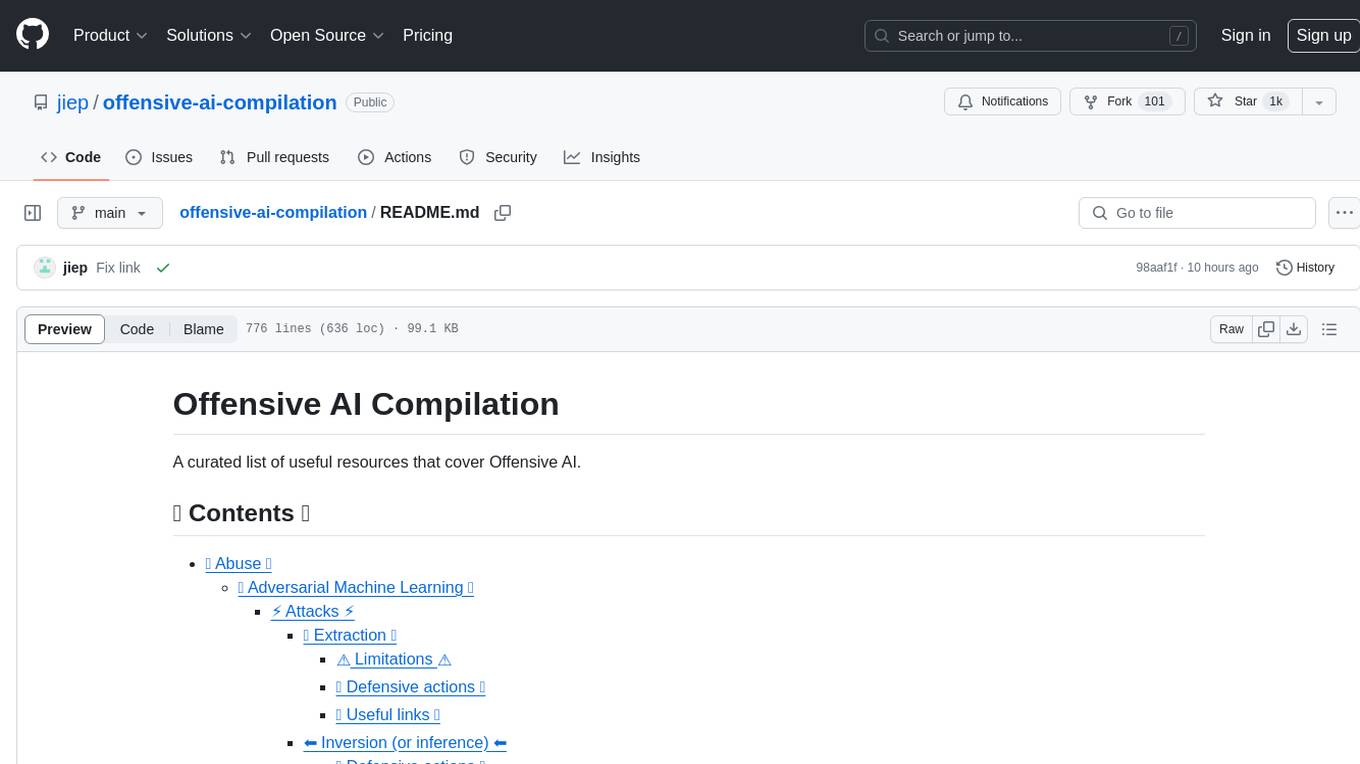
Open-Sora-Plan
This project aim to reproduce Sora (Open AI T2V model), we wish the open source community contribute to this project.
Stars: 11754
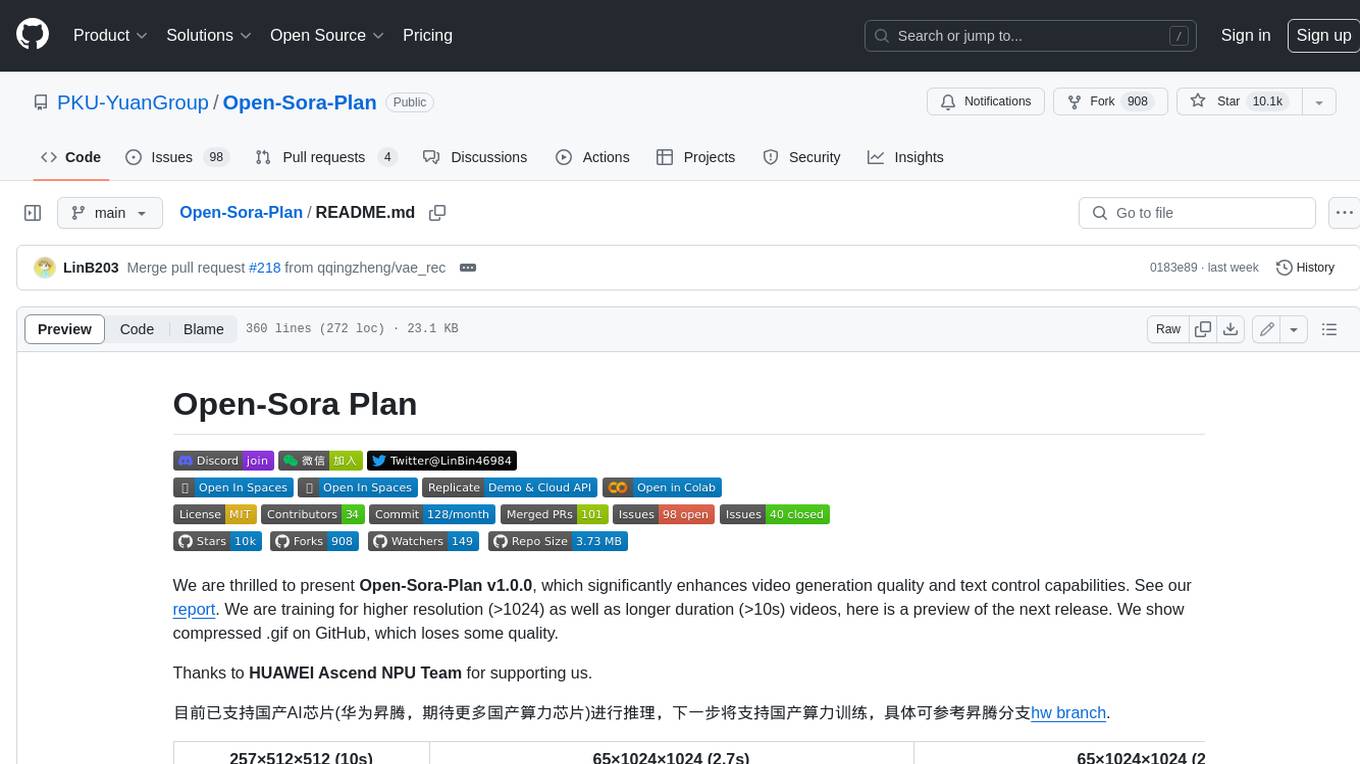
Open-Sora-Plan is a project that aims to create a simple and scalable repo to reproduce Sora (OpenAI, but we prefer to call it "ClosedAI"). The project is still in its early stages, but the team is working hard to improve it and make it more accessible to the open-source community. The project is currently focused on training an unconditional model on a landscape dataset, but the team plans to expand the scope of the project in the future to include text2video experiments, training on video2text datasets, and controlling the model with more conditions.
README:
This project aims to create a simple and scalable repo, to reproduce Sora (OpenAI, but we prefer to call it "ClosedAI" ). We wish the open-source community can contribute to this project. Pull requests are welcome! The current code supports complete training and inference using the Huawei Ascend AI computing system. Models trained on Huawei Ascend can also output video quality comparable to industry standards.
本项目希望通过开源社区的力量复现Sora,由北大-兔展AIGC联合实验室共同发起,当前版本离目标差距仍然较大,仍需持续完善和快速迭代,欢迎Pull request!目前代码同时支持使用国产AI计算系统(华为昇腾)进行完整的训练和推理。基于昇腾训练出的模型,也可输出持平业界的视频质量。
-
COMING SOON⚡️⚡️⚡️ For large model parallelisation training, TP & SP and more strategies are coming...近期将新增华为昇腾多模态MindSpeed-MM分支,借助华为MindSpeed-MM套件的能力支撑Open-Sora Plan参数的扩增,为更大参数规模的模型训练提供TP、SP等分布式训练能力。
-
[2024.12.03] ⚡️ We released our arxiv paper and WF-VAE paper for v1.3. The next more powerful version is coming soon.
-
[2024.10.16] 🎉 We released version 1.3.0, featuring: WFVAE, prompt refiner, data filtering strategy, sparse attention, and bucket training strategy. We also support 93x480p within 24G VRAM. More details can be found at our latest report.
-
[2024.08.13] 🎉 We are launching Open-Sora Plan v1.2.0 I2V model, which is based on Open-Sora Plan v1.2.0. The current version supports image-to-video generation and transition generation (the starting and ending frames conditions for video generation). Check out the Image-to-Video section in this report.
-
[2024.07.24] 🔥🔥🔥 v1.2.0 is here! Utilizing a 3D full attention architecture instead of 2+1D. We released a true 3D video diffusion model trained on 4s 720p. Check out our latest report.
-
[2024.05.27] 🎉 We are launching Open-Sora Plan v1.1.0, which significantly improves video quality and length, and is fully open source! Please check out our latest report. Thanks to ShareGPT4Video's capability to annotate long videos.
-
[2024.04.09] 🤝 Excited to share our latest exploration on metamorphic time-lapse video generation: MagicTime, which learns real-world physics knowledge from time-lapse videos.
-
[2024.04.07] 🎉🎉🎉 Today, we are thrilled to present Open-Sora-Plan v1.0.0, which significantly enhances video generation quality and text control capabilities. See our report. Thanks to HUAWEI NPU for supporting us.
-
[2024.03.27] 🚀🚀🚀 We release the report of VideoCausalVAE, which supports both images and videos. We present our reconstructed video in this demonstration as follows. The text-to-video model is on the way.
-
[2024.03.01] 🤗 We launched a plan to reproduce Sora, called Open-Sora Plan! Welcome to watch 👀 this repository for the latest updates.
Text & Image to Video Generation.
Open-Sora Plan shows excellent performance in video generation.
- High compression ratio with excellent performance, capable of compressing videos by 256 times (4×8×8). Causal convolution supports simultaneous inference of images and videos but only need 1 node to train.
- With a new sparse attention architecture instead of a 2+1D model, 3D attention can better capture joint spatial and temporal features.
Highly recommend trying out our web demo by the following command.
python -m opensora.serve.gradio_web_server --model_path "path/to/model" \
--ae WFVAEModel_D8_4x8x8 --ae_path "path/to/vae" \
--caption_refiner "path/to/refiner" \
--text_encoder_name_1 "path/to/text_enc" --rescale_betas_zero_snrComing soon...
| Version | Architecture | Diffusion Model | CausalVideoVAE | Data | Prompt Refiner |
|---|---|---|---|---|---|
| v1.3.0 [4] | Skiparse 3D | Anysize in 93x640x640[3], Anysize in 93x640x640_i2v[3] | Anysize | prompt_refiner | checkpoint |
| v1.2.0 | Dense 3D | 93x720p, 29x720p[1], 93x480p[1,2], 29x480p, 1x480p, 93x480p_i2v | Anysize | Annotations | - |
| v1.1.0 | 2+1D | 221x512x512, 65x512x512 | Anysize | Data and Annotations | - |
| v1.0.0 | 2+1D | 65x512x512, 65x256x256, 17x256x256 | Anysize | Data and Annotations | - |
[1] Please note that the weights for v1.2.0 29×720p and 93×480p were trained on Panda70M and have not undergone final high-quality data fine-tuning, so they may produce watermarks.
[2] We fine-tuned 3.5k steps from 93×720p to get 93×480p for community research use.
[3] The model is trained arbitrarily on stride=32. So keep the resolution of the inference a multiple of 32. Frames need to be 4n+1, e.g. 93, 77, 61, 45, 29, 1 (image).
[4] Model weights are also available at OpenMind and WiseModel.
[!Warning]
🚨 For version 1.2.0, we no longer support 2+1D models.
- Clone this repository and navigate to Open-Sora-Plan folder
git clone https://github.com/PKU-YuanGroup/Open-Sora-Plan
cd Open-Sora-Plan
- Install required packages We recommend the requirements as follows.
- Python >= 3.8
- Pytorch >= 2.1.0
conda create -n opensora python=3.8 -y
conda activate opensora
pip install -e .
pip install torch_npu==2.1.0.post6
# ref https://github.com/dmlc/decord
git clone --recursive https://github.com/dmlc/decord
mkdir build && cd build
cmake .. -DUSE_CUDA=0 -DCMAKE_BUILD_TYPE=Release -DFFMPEG_DIR=/usr/local/ffmpeg
make
cd ../python
pwd=$PWD
echo "PYTHONPATH=$PYTHONPATH:$pwd" >> ~/.bashrc
source ~/.bashrc
python3 setup.py install --user
- Install optional requirements such as static type checking:
pip install -e '.[dev]'
The data preparation, training, inferencing and evaluation can be found here
The data preparation, training, inferencing can be found here
The data preparation, training and inferencing can be found here
The data preparation, training and inferencing can be found here
During training, the entire EMA model remains in VRAM. You can enable --offload_ema or disable --use_ema. Additionally, VAE tiling is disabled by default, but you can pass --enable_tiling or disable --vae_fp32. Finally, a temporary but extreme saving memory option is enable --extra_save_mem to offload the text encoder and VAE to the CPU when not in use, though this will significantly slow down performance.
We currently have two plans: one is to continue using the Deepspeed/FSDP approach, sharding the EMA and text encoder across ranks with Zero3, which is sufficient for training 10-15B models. The other is to adopt MindSpeed for various parallel strategies, enabling us to scale the model up to 30B.
Please first ensure that you understand how to inference. Refer to the inference instructions in Text-to-Video.
Simply specify --save_memory, and during inference, enable_model_cpu_offload(), enable_sequential_cpu_offload(), and vae.vae.enable_tiling() will be automatically activated.
We greatly appreciate your contributions to the Open-Sora Plan open-source community and helping us make it even better than it is now!
For more details, please refer to the Contribution Guidelines
- Allegro: Allegro is a powerful text-to-video model that generates high-quality videos up to 6 seconds at 15 FPS and 720p resolution from simple text input based on our Open-Sora Plan. The significance of open-source is becoming increasingly tangible.
- Latte: It is a wonderful 2+1D video generation model.
- PixArt-alpha: Fast Training of Diffusion Transformer for Photorealistic Text-to-Image Synthesis.
- ShareGPT4Video: Improving Video Understanding and Generation with Better Captions.
- VideoGPT: Video Generation using VQ-VAE and Transformers.
- DiT: Scalable Diffusion Models with Transformers.
- FiT: Flexible Vision Transformer for Diffusion Model.
- Positional Interpolation: Extending Context Window of Large Language Models via Positional Interpolation.
- See LICENSE for details.
@article{lin2024open,
title={Open-Sora Plan: Open-Source Large Video Generation Model},
author={Lin, Bin and Ge, Yunyang and Cheng, Xinhua and Li, Zongjian and Zhu, Bin and Wang, Shaodong and He, Xianyi and Ye, Yang and Yuan, Shenghai and Chen, Liuhan and others},
journal={arXiv preprint arXiv:2412.00131},
year={2024}
}@article{li2024wf,
title={WF-VAE: Enhancing Video VAE by Wavelet-Driven Energy Flow for Latent Video Diffusion Model},
author={Li, Zongjian and Lin, Bin and Ye, Yang and Chen, Liuhan and Cheng, Xinhua and Yuan, Shenghai and Yuan, Li},
journal={arXiv preprint arXiv:2411.17459},
year={2024}
}For Tasks:
Click tags to check more tools for each tasksFor Jobs:
Alternative AI tools for Open-Sora-Plan
Similar Open Source Tools

Open-Sora-Plan
Open-Sora-Plan is a project that aims to create a simple and scalable repo to reproduce Sora (OpenAI, but we prefer to call it "ClosedAI"). The project is still in its early stages, but the team is working hard to improve it and make it more accessible to the open-source community. The project is currently focused on training an unconditional model on a landscape dataset, but the team plans to expand the scope of the project in the future to include text2video experiments, training on video2text datasets, and controlling the model with more conditions.
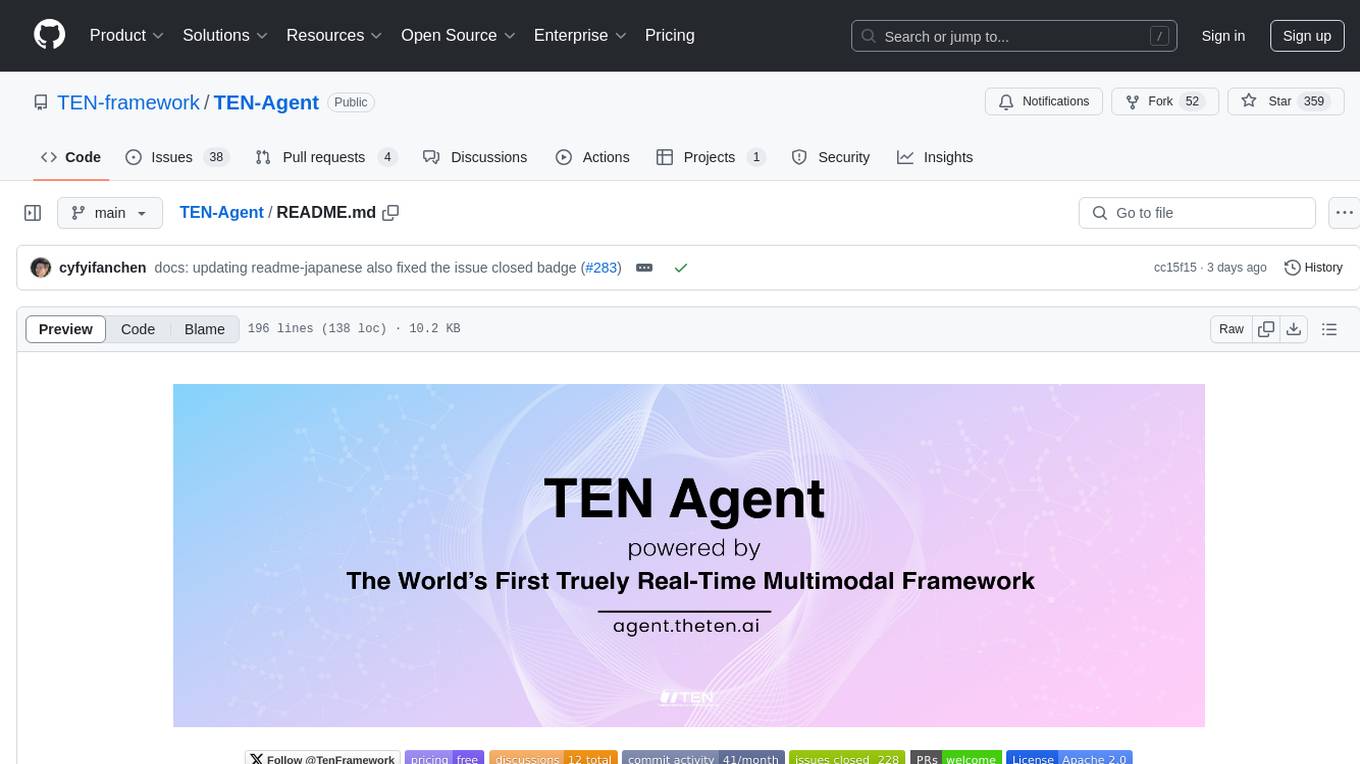
TEN-Agent
TEN Agent is an open-source multimodal agent powered by the world’s first real-time multimodal framework, TEN Framework. It offers high-performance real-time multimodal interactions, multi-language and multi-platform support, edge-cloud integration, flexibility beyond model limitations, and real-time agent state management. Users can easily build complex AI applications through drag-and-drop programming, integrating audio-visual tools, databases, RAG, and more.
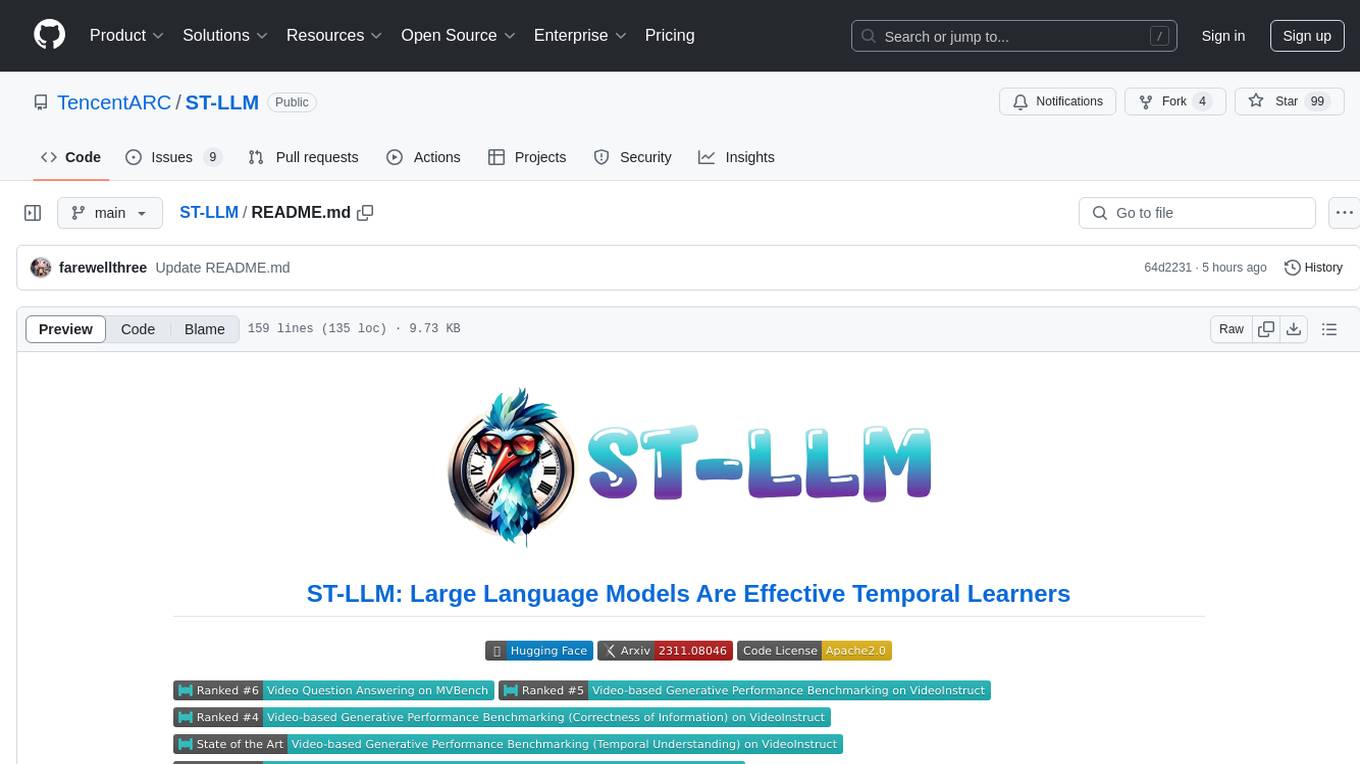
ST-LLM
ST-LLM is a temporal-sensitive video large language model that incorporates joint spatial-temporal modeling, dynamic masking strategy, and global-local input module for effective video understanding. It has achieved state-of-the-art results on various video benchmarks. The repository provides code and weights for the model, along with demo scripts for easy usage. Users can train, validate, and use the model for tasks like video description, action identification, and reasoning.
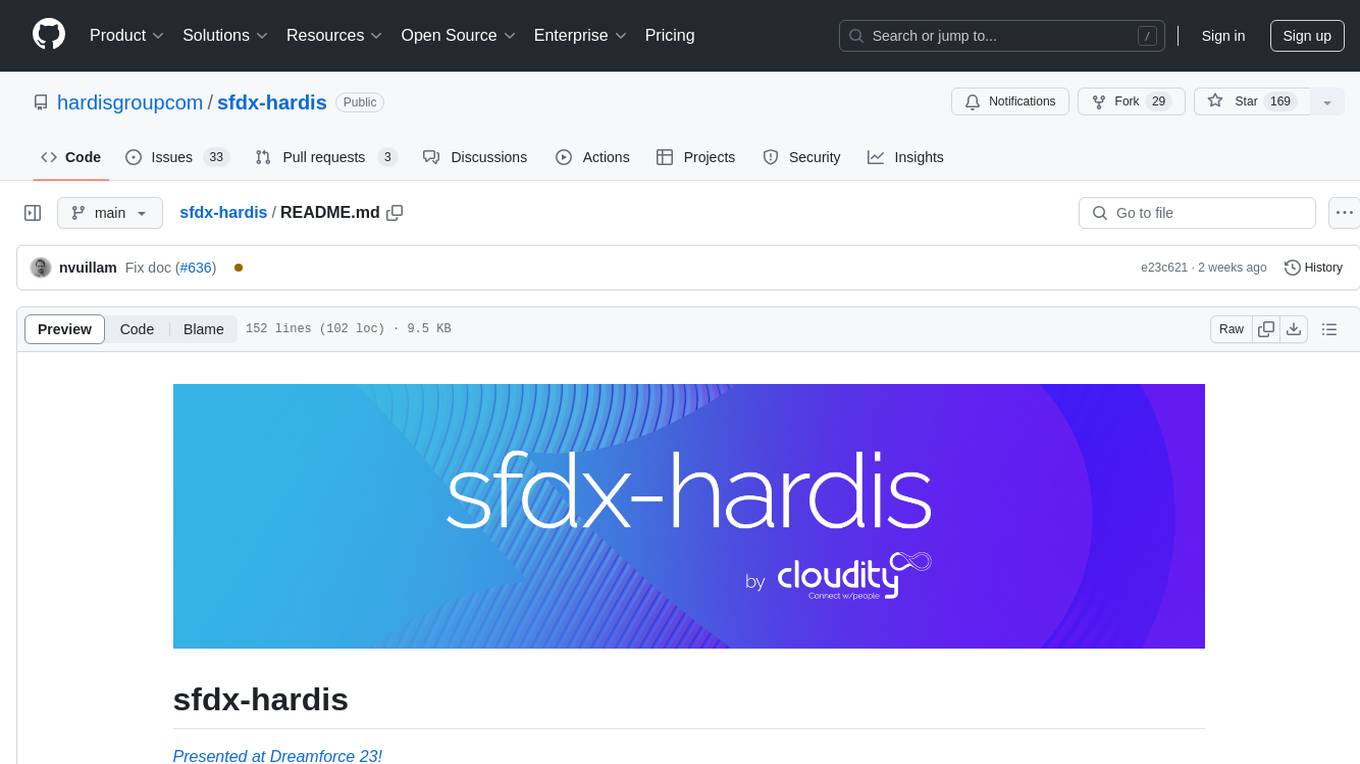
sfdx-hardis
sfdx-hardis is a toolbox for Salesforce DX, developed by Cloudity, that simplifies tasks which would otherwise take minutes or hours to complete manually. It enables users to define complete CI/CD pipelines for Salesforce projects, backup metadata, and monitor any Salesforce org. The tool offers a wide range of commands that can be accessed via the command line interface or through a Visual Studio Code extension. Additionally, sfdx-hardis provides Docker images for easy integration into CI workflows. The tool is designed to be natively compliant with various platforms and tools, making it a versatile solution for Salesforce developers.
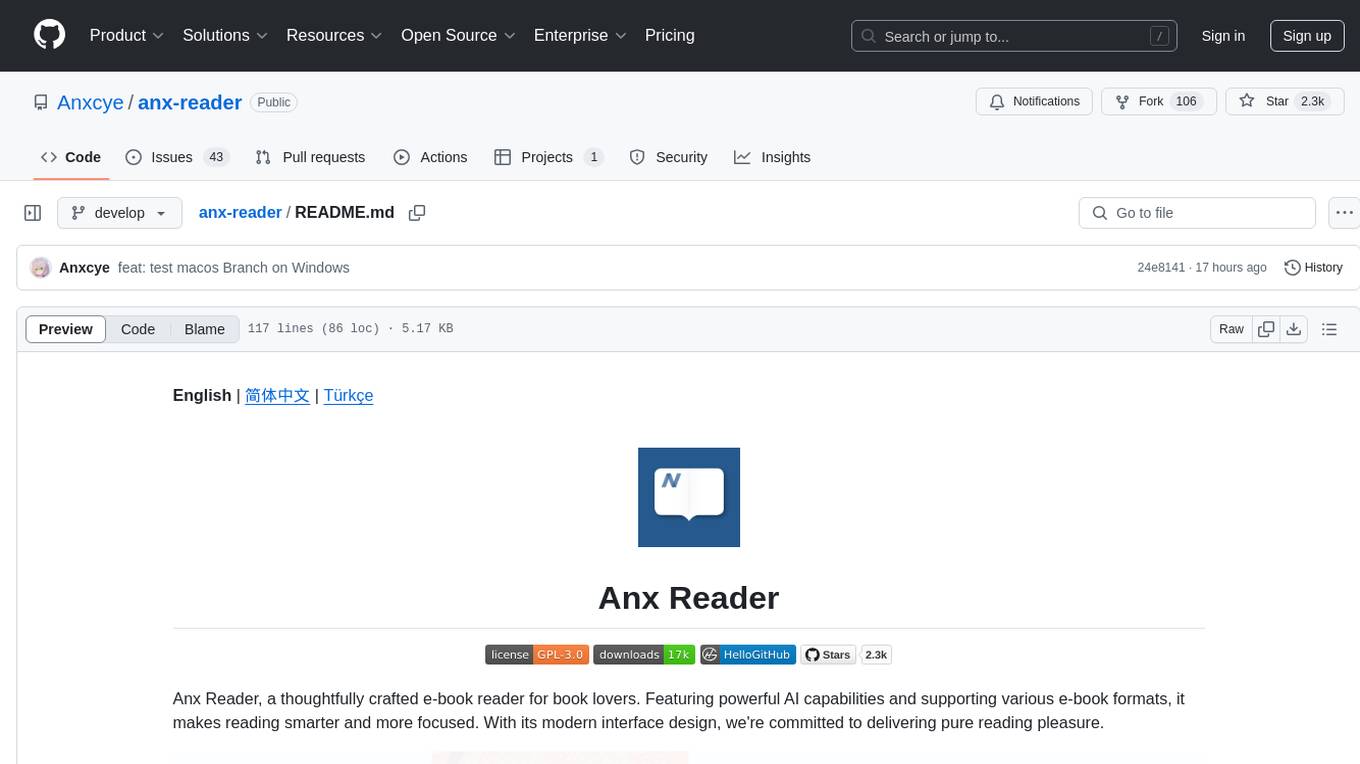
anx-reader
Anx Reader is a meticulously designed e-book reader tailored for book enthusiasts. It boasts powerful AI functionalities and supports various e-book formats, enhancing the reading experience. With a modern interface, the tool aims to provide a seamless and enjoyable reading journey. It offers rich format support, seamless sync across devices, smart AI assistance, personalized reading experiences, professional reading analytics, a powerful note system, practical tools, and cross-platform support. The tool is continuously evolving with features like UI adaptation for tablets, page-turning animation, TTS voice reading, reading fonts, translation, and more in the pipeline.
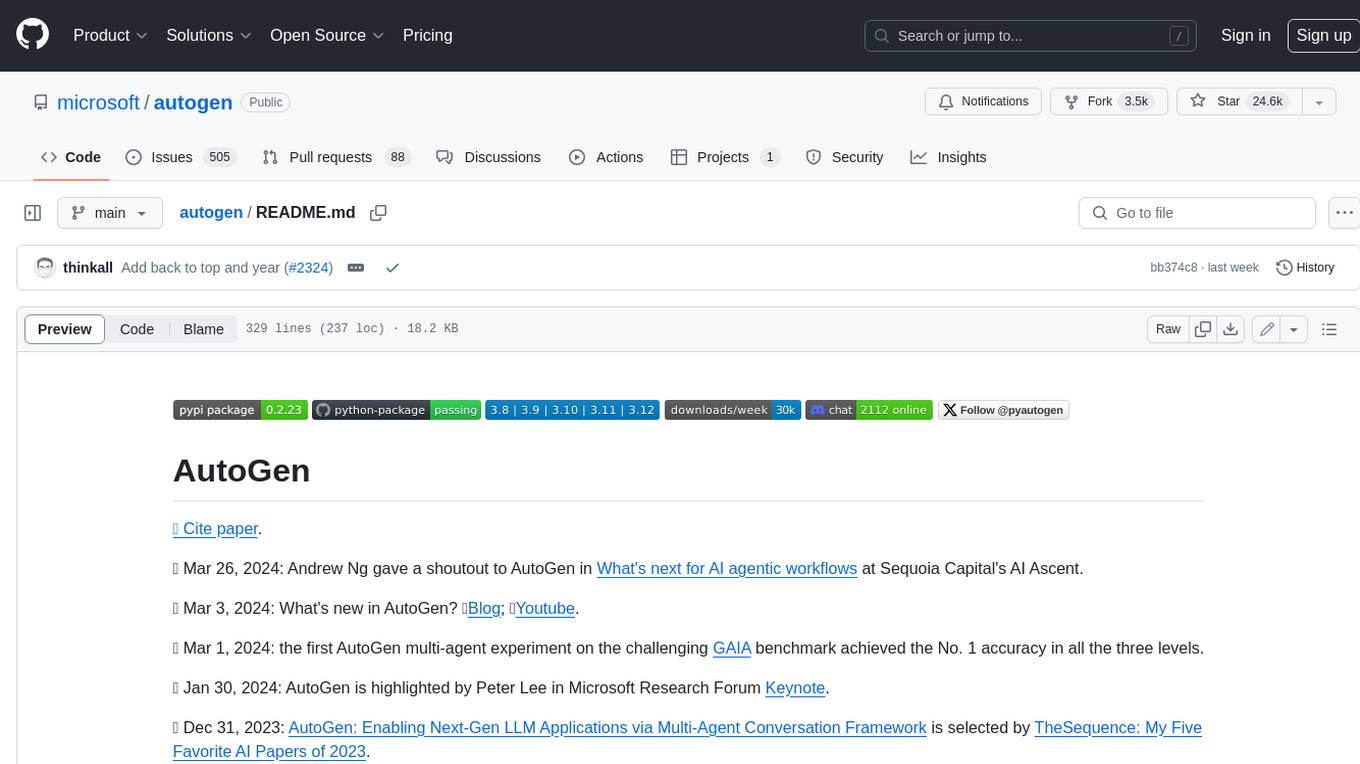
autogen
AutoGen is a framework that enables the development of LLM applications using multiple agents that can converse with each other to solve tasks. AutoGen agents are customizable, conversable, and seamlessly allow human participation. They can operate in various modes that employ combinations of LLMs, human inputs, and tools.
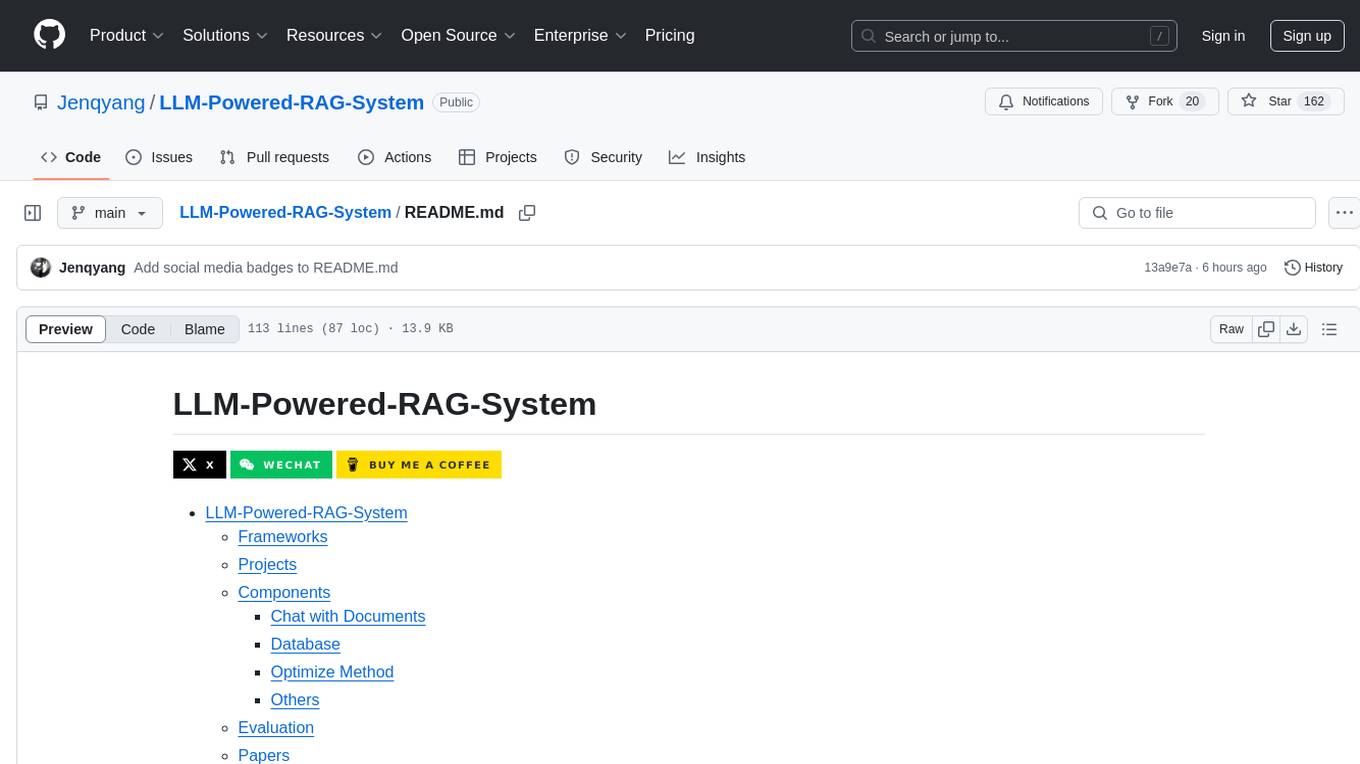
LLM-Powered-RAG-System
LLM-Powered-RAG-System is a comprehensive repository containing frameworks, projects, components, evaluation tools, papers, blogs, and other resources related to Retrieval-Augmented Generation (RAG) systems powered by Large Language Models (LLMs). The repository includes various frameworks for building applications with LLMs, data frameworks, modular graph-based RAG systems, dense retrieval models, and efficient retrieval augmentation and generation frameworks. It also features projects such as personal productivity assistants, knowledge-based platforms, chatbots, question and answer systems, and code assistants. Additionally, the repository provides components for interacting with documents, databases, and optimization methods using ML and LLM technologies. Evaluation frameworks, papers, blogs, and other resources related to RAG systems are also included.
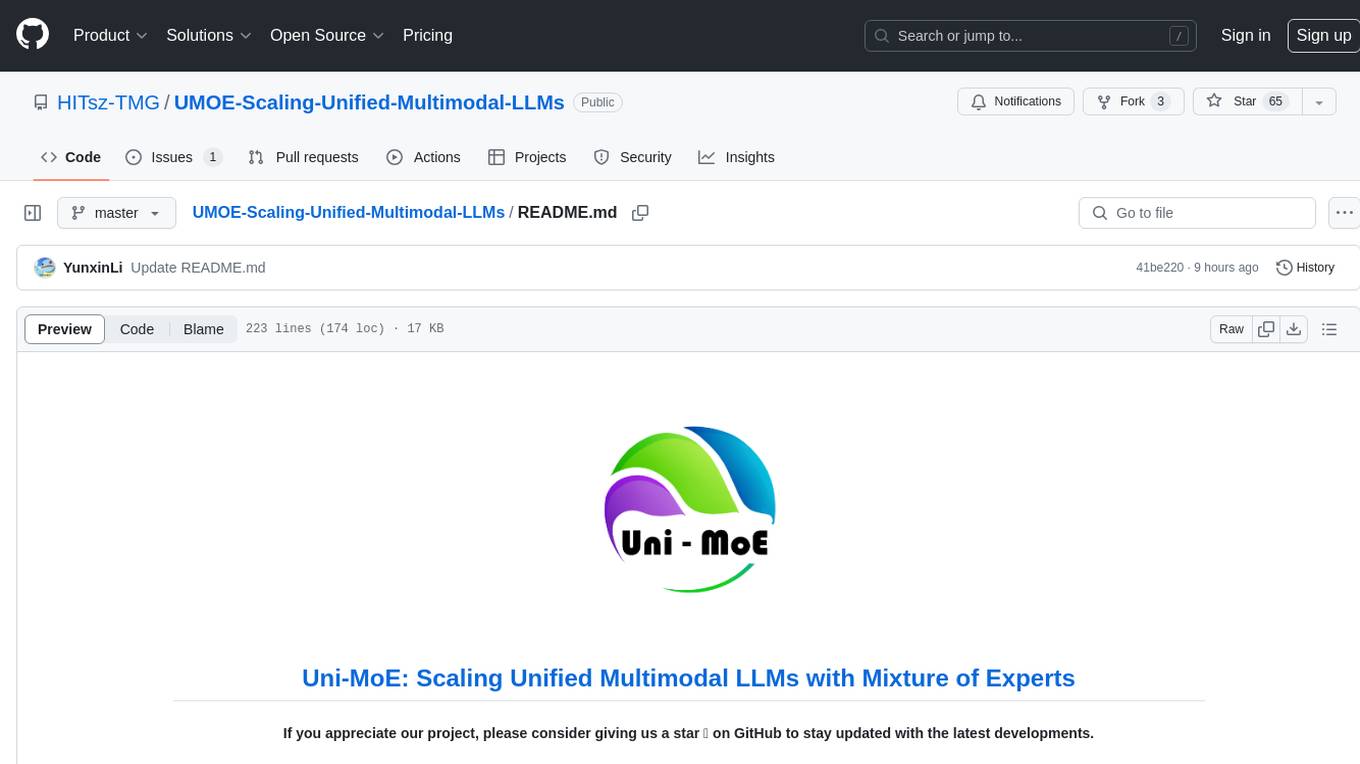
UMOE-Scaling-Unified-Multimodal-LLMs
Uni-MoE is a MoE-based unified multimodal model that can handle diverse modalities including audio, speech, image, text, and video. The project focuses on scaling Unified Multimodal LLMs with a Mixture of Experts framework. It offers enhanced functionality for training across multiple nodes and GPUs, as well as parallel processing at both the expert and modality levels. The model architecture involves three training stages: building connectors for multimodal understanding, developing modality-specific experts, and incorporating multiple trained experts into LLMs using the LoRA technique on mixed multimodal data. The tool provides instructions for installation, weights organization, inference, training, and evaluation on various datasets.
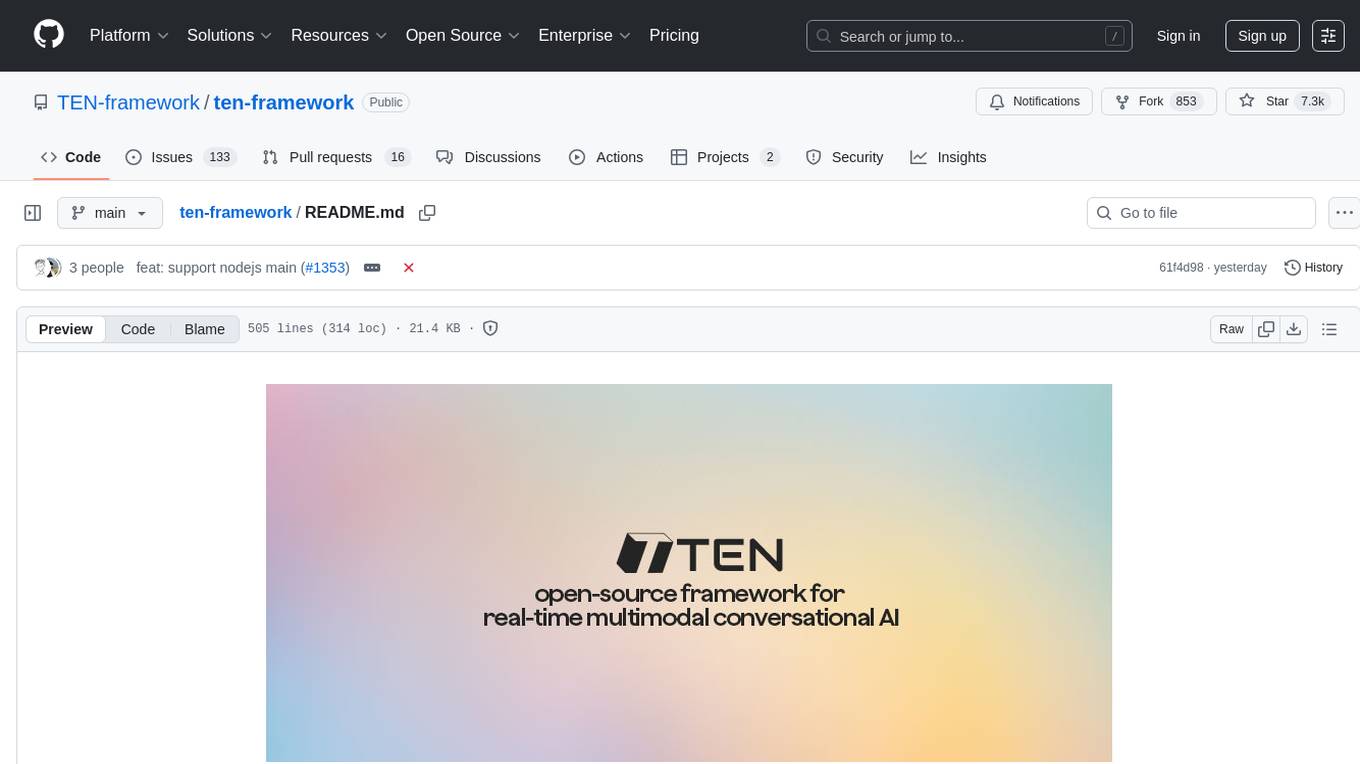
ten-framework
TEN is an open-source ecosystem for creating, customizing, and deploying real-time conversational AI agents with multimodal capabilities including voice, vision, and avatar interactions. It includes various components like TEN Framework, TEN Turn Detection, TEN VAD, TEN Agent, TMAN Designer, and TEN Portal. Users can follow the provided guidelines to set up and customize their agents using TMAN Designer, run them locally or in Codespace, and deploy them with Docker or other cloud services. The ecosystem also offers community channels for developers to connect, contribute, and get support.
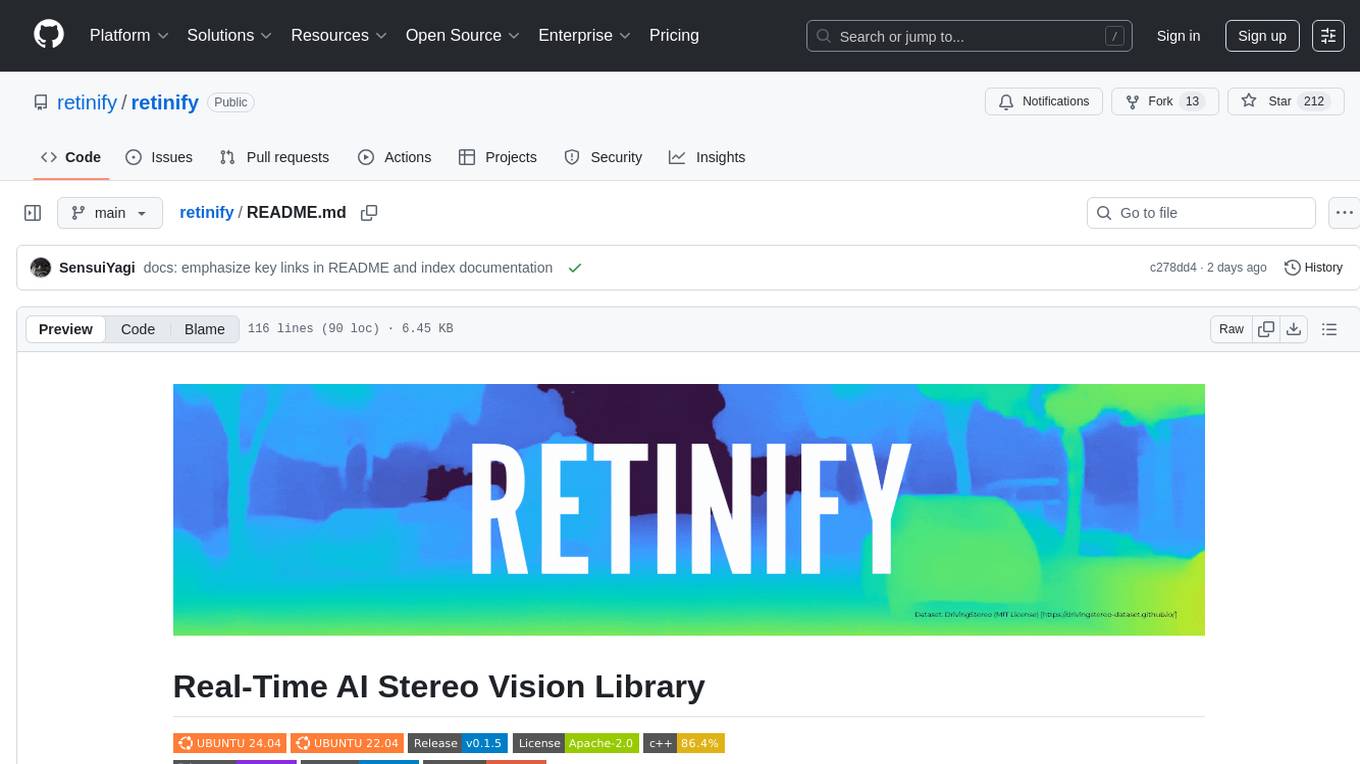
retinify
Retinify is an advanced AI-powered stereo vision library designed for robotics, enabling real-time, high-precision 3D perception by leveraging GPU and NPU acceleration. It is open source under Apache-2.0 license, offers high precision 3D mapping and object recognition, runs computations on GPU for fast performance, accepts stereo images from any rectified camera setup, is cost-efficient using minimal hardware, and has minimal dependencies on CUDA Toolkit, cuDNN, and TensorRT. The tool provides a pipeline for stereo matching and supports various image data types independently of OpenCV.
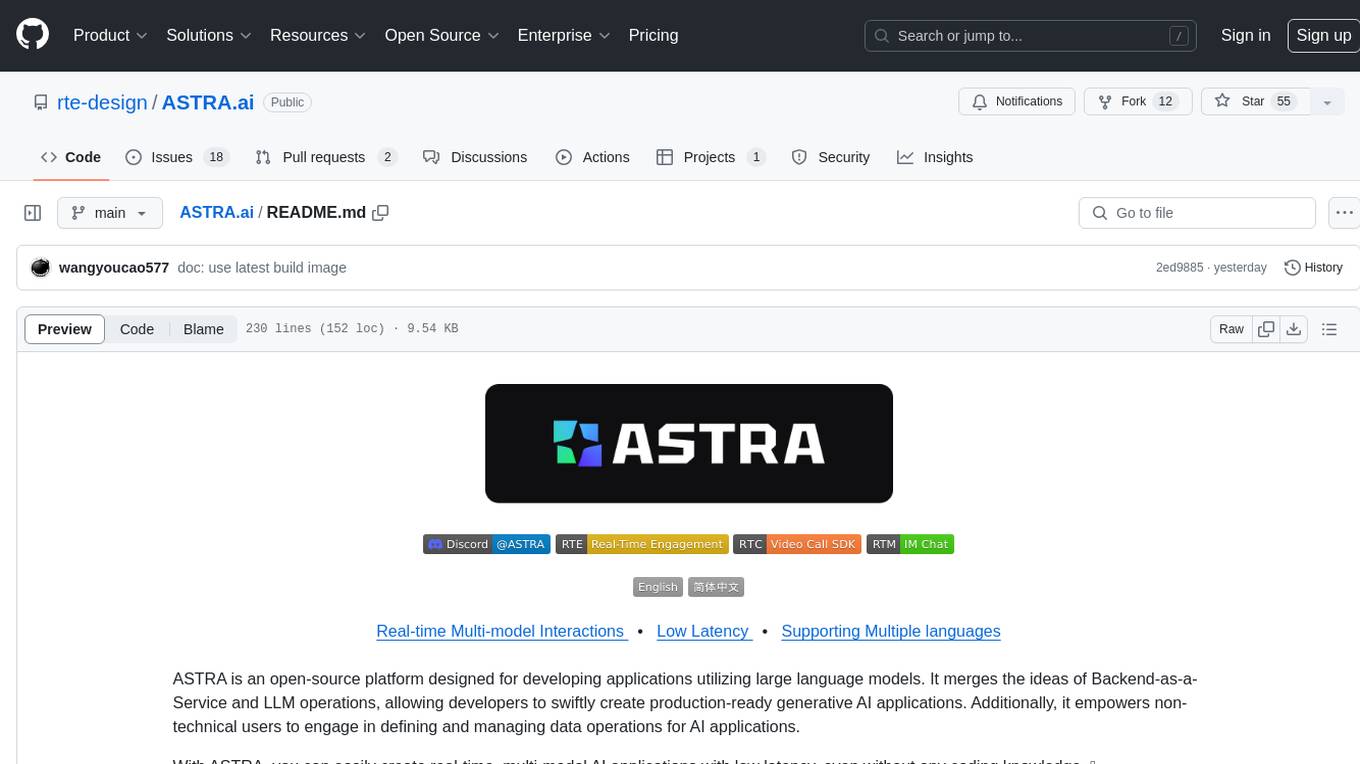
ASTRA.ai
ASTRA is an open-source platform designed for developing applications utilizing large language models. It merges the ideas of Backend-as-a-Service and LLM operations, allowing developers to swiftly create production-ready generative AI applications. Additionally, it empowers non-technical users to engage in defining and managing data operations for AI applications. With ASTRA, you can easily create real-time, multi-modal AI applications with low latency, even without any coding knowledge.
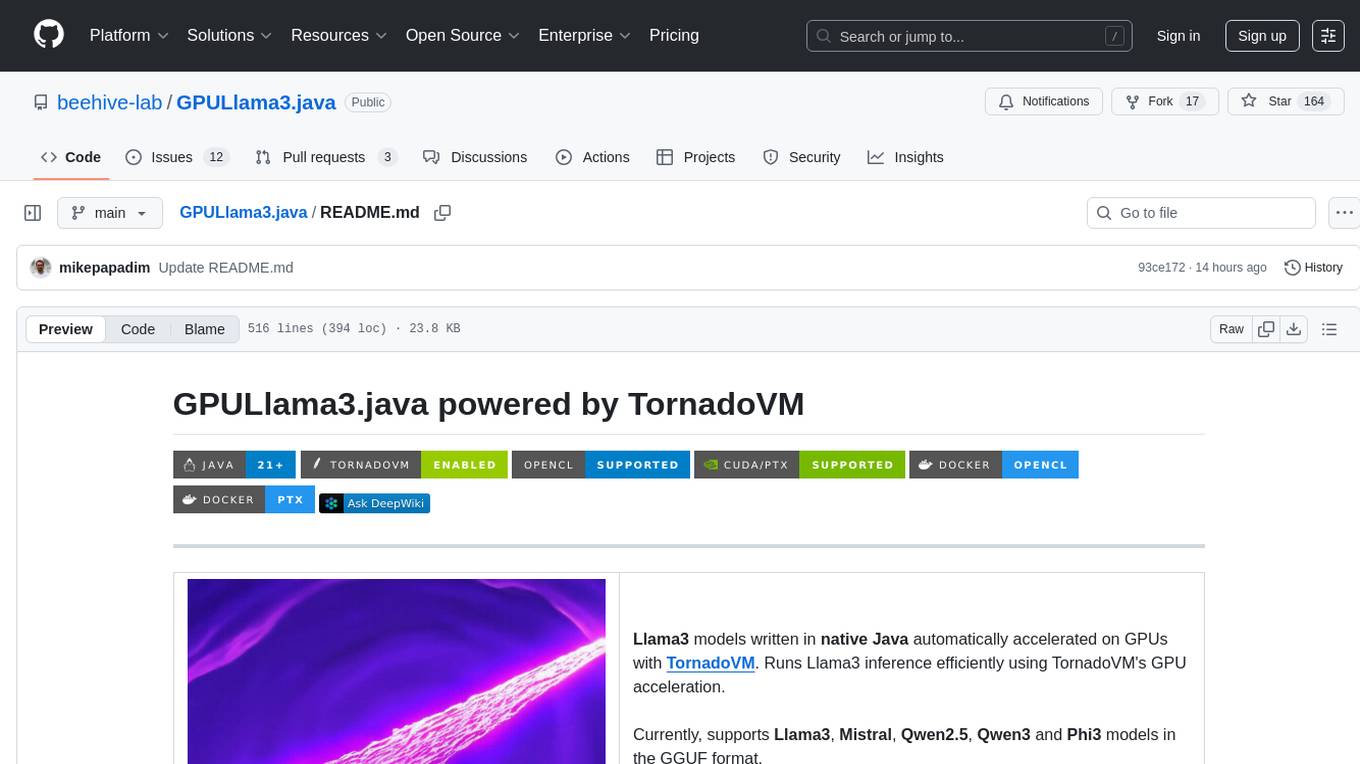
GPULlama3.java
GPULlama3.java powered by TornadoVM is a Java-native implementation of Llama3 that automatically compiles and executes Java code on GPUs via TornadoVM. It supports Llama3, Mistral, Qwen2.5, Qwen3, and Phi3 models in the GGUF format. The repository aims to provide GPU acceleration for Java code, enabling faster execution and high-performance access to off-heap memory. It offers features like interactive and instruction modes, flexible backend switching between OpenCL and PTX, and cross-platform compatibility with NVIDIA, Intel, and Apple GPUs.
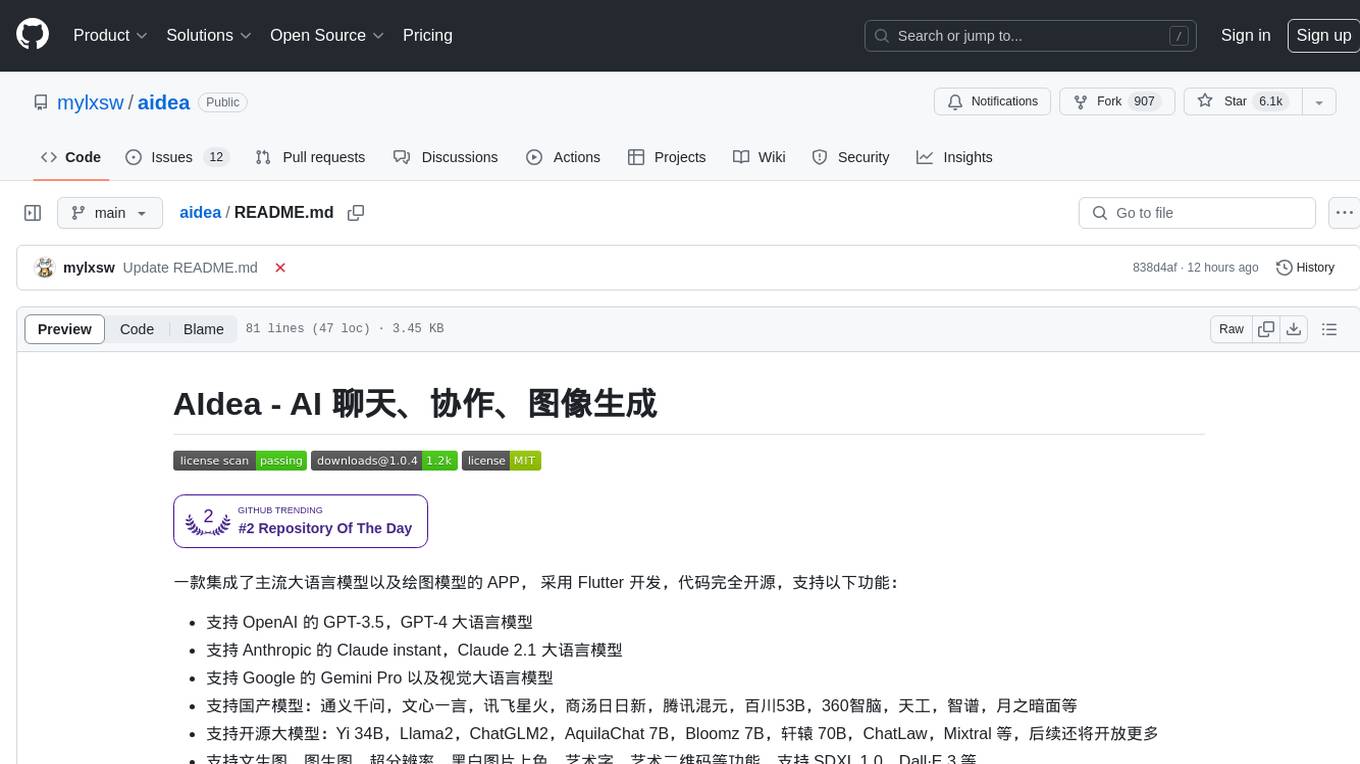
aidea
AIdea is an app that integrates mainstream large language models and drawing models, developed using Flutter. The code is completely open-source and supports various functions such as GPT-3.5, GPT-4 from OpenAI, Claude instant, Claude 2.1 from Anthropic, Gemini Pro and visual language models from Google, as well as various Chinese and open-source models. It also supports features like text-to-image, super-resolution, coloring black and white images, artistic fonts, artistic QR codes, and more.
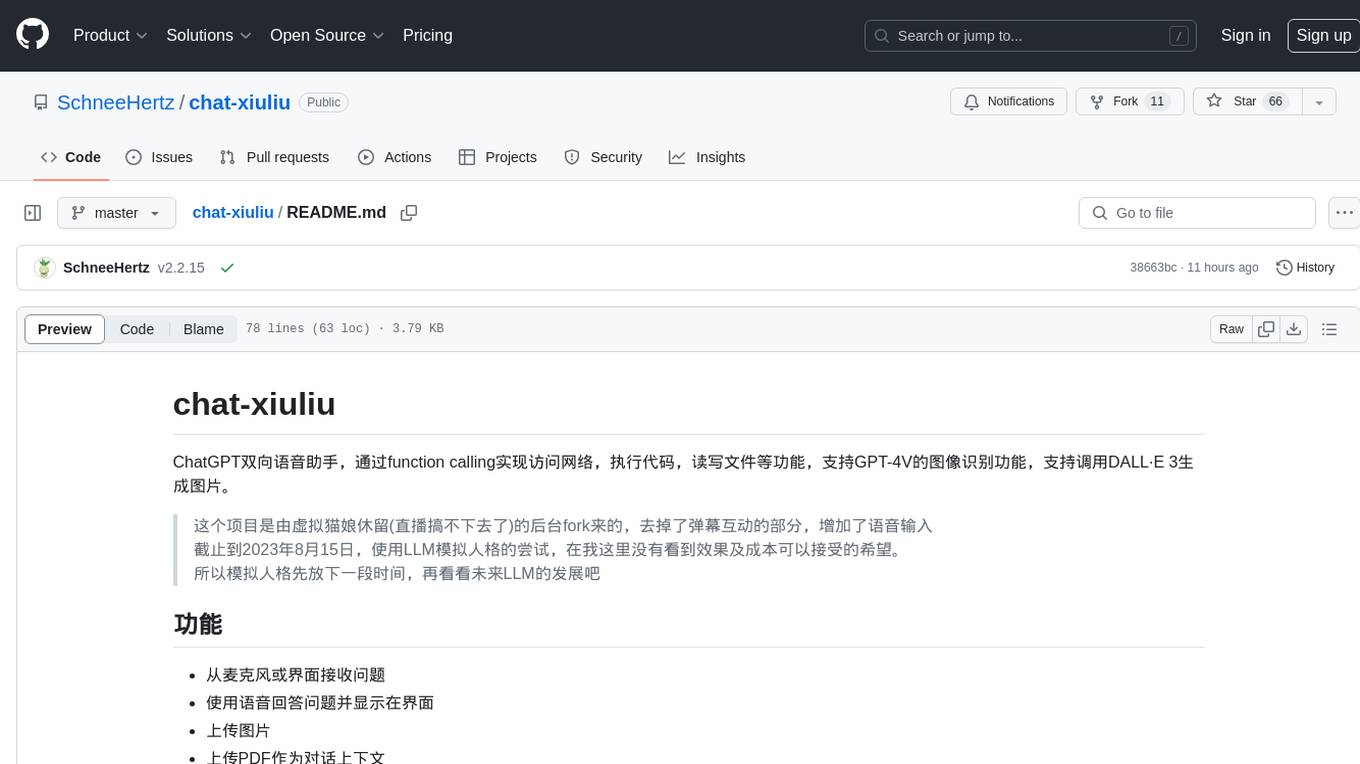
chat-xiuliu
Chat-xiuliu is a bidirectional voice assistant powered by ChatGPT, capable of accessing the internet, executing code, reading/writing files, and supporting GPT-4V's image recognition feature. It can also call DALL·E 3 to generate images. The project is a fork from a background of a virtual cat girl named Xiuliu, with removed live chat interaction and added voice input. It can receive questions from microphone or interface, answer them vocally, upload images and PDFs, process tasks through function calls, remember conversation content, search the web, generate images using DALL·E 3, read/write local files, execute JavaScript code in a sandbox, open local files or web pages, customize the cat girl's speaking style, save conversation screenshots, and support Azure OpenAI and other API endpoints in openai format. It also supports setting proxies and various AI models like GPT-4, GPT-3.5, and DALL·E 3.
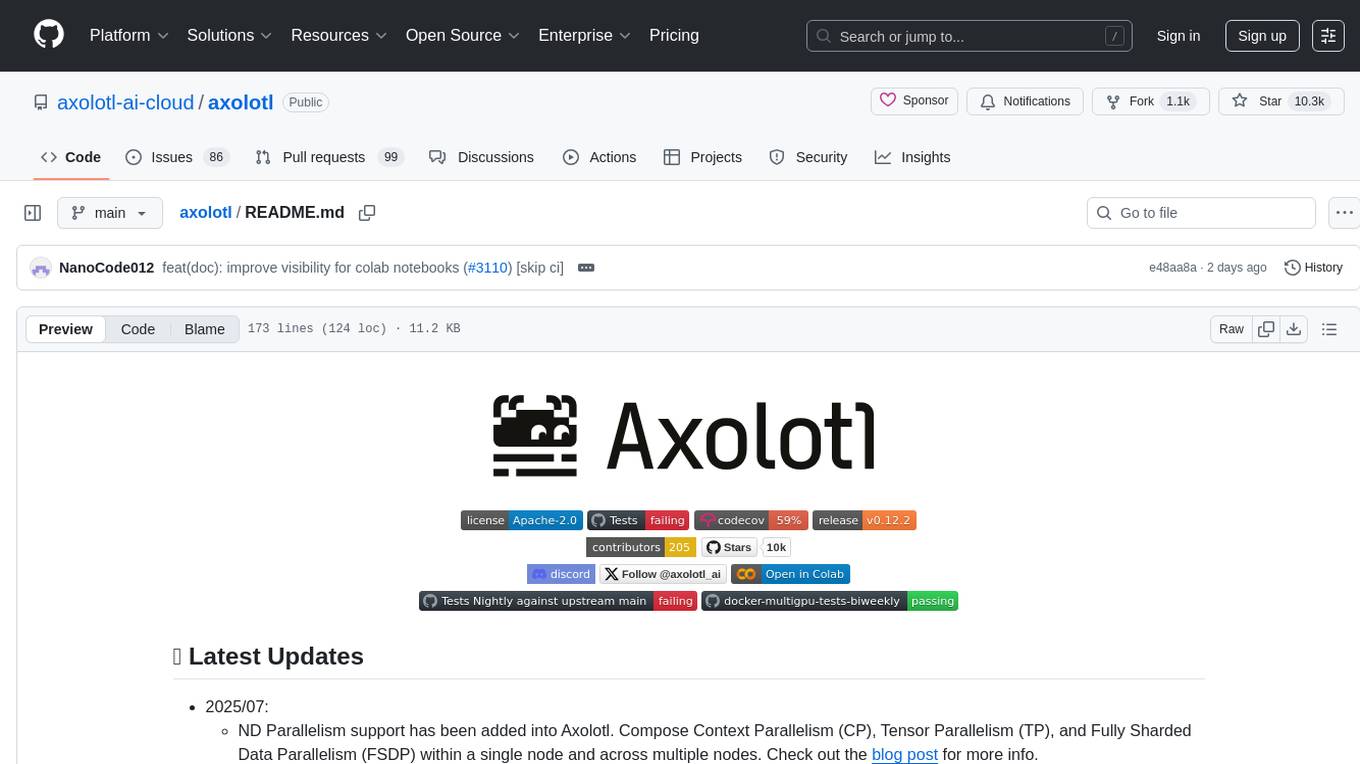
axolotl
Axolotl is a lightweight and efficient tool for managing and analyzing large datasets. It provides a user-friendly interface for data manipulation, visualization, and statistical analysis. With Axolotl, users can easily import, clean, and explore data to gain valuable insights and make informed decisions. The tool supports various data formats and offers a wide range of functions for data processing and modeling. Whether you are a data scientist, researcher, or business analyst, Axolotl can help streamline your data workflows and enhance your data analysis capabilities.
For similar tasks
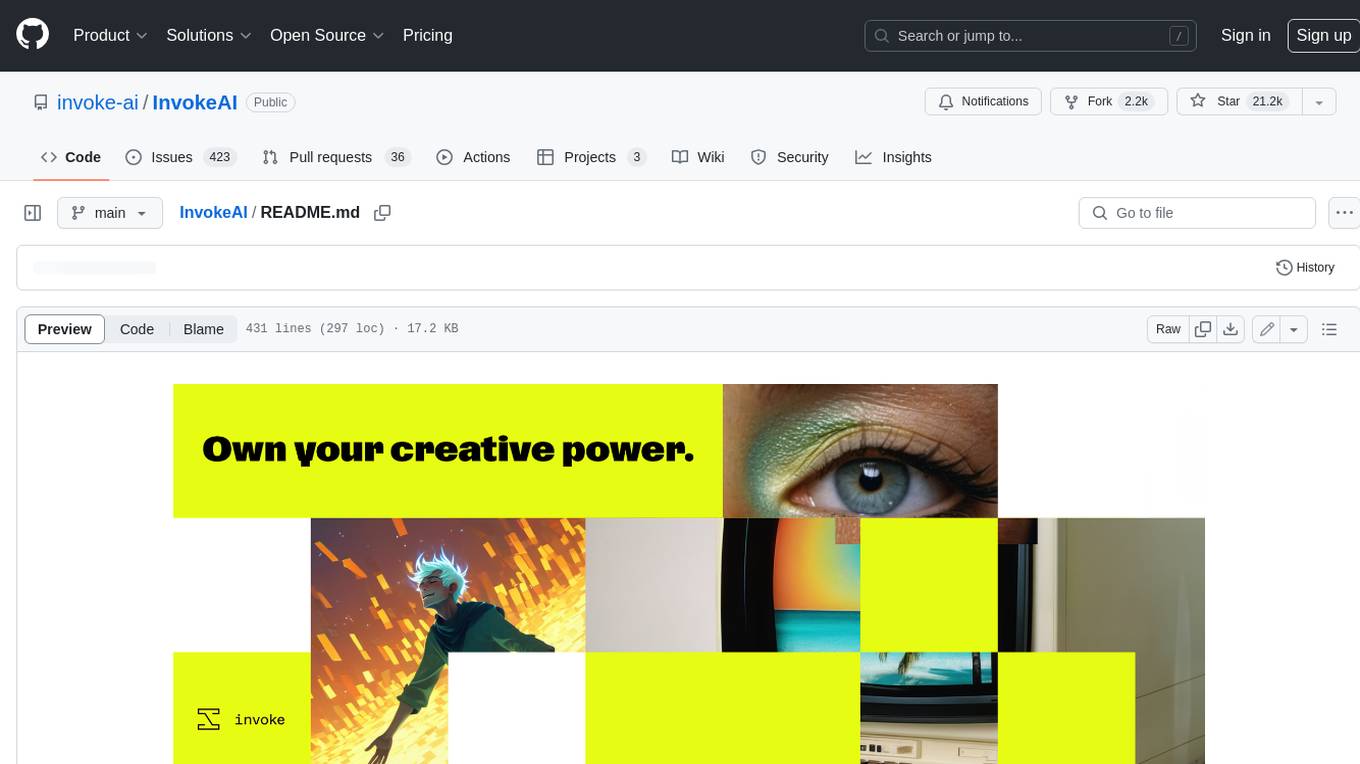
InvokeAI
InvokeAI is a leading creative engine built to empower professionals and enthusiasts alike. Generate and create stunning visual media using the latest AI-driven technologies. InvokeAI offers an industry leading Web Interface, interactive Command Line Interface, and also serves as the foundation for multiple commercial products.

Open-Sora-Plan
Open-Sora-Plan is a project that aims to create a simple and scalable repo to reproduce Sora (OpenAI, but we prefer to call it "ClosedAI"). The project is still in its early stages, but the team is working hard to improve it and make it more accessible to the open-source community. The project is currently focused on training an unconditional model on a landscape dataset, but the team plans to expand the scope of the project in the future to include text2video experiments, training on video2text datasets, and controlling the model with more conditions.
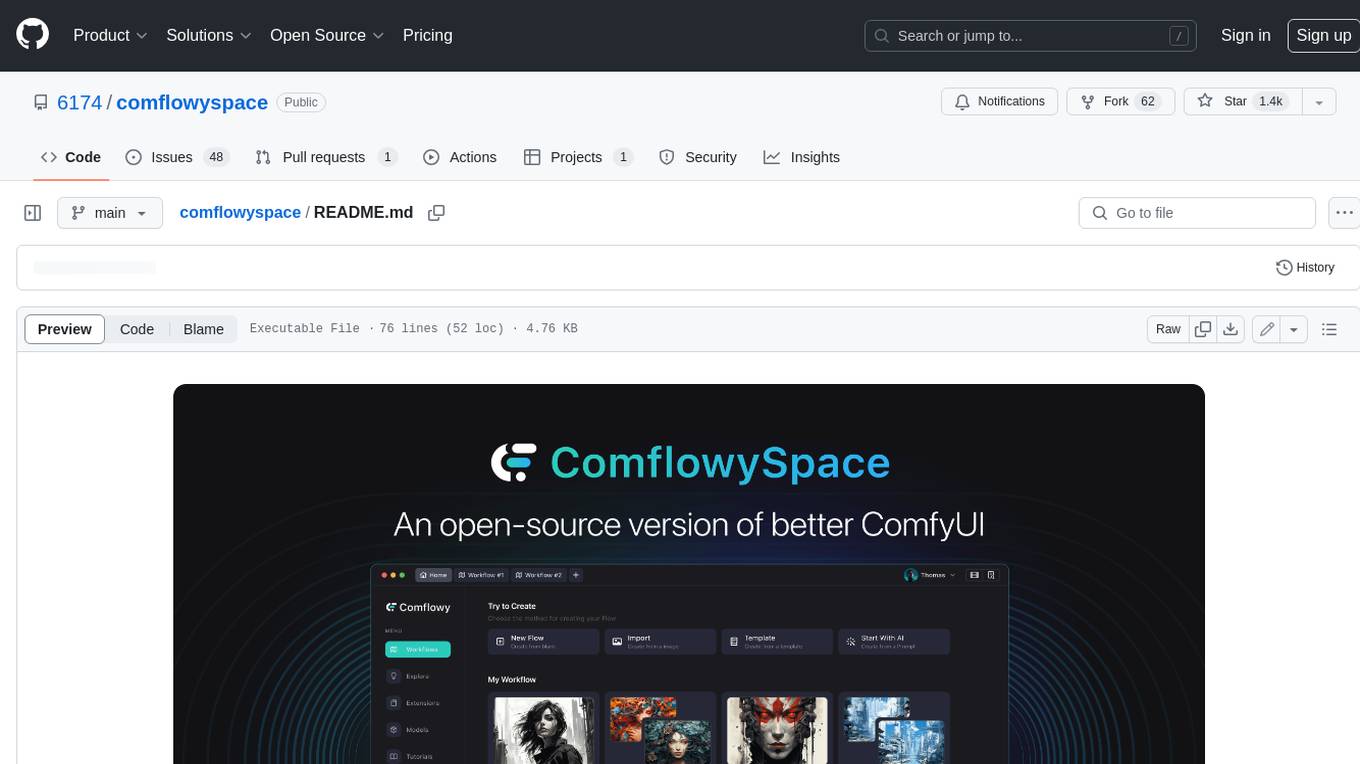
comflowyspace
Comflowyspace is an open-source AI image and video generation tool that aims to provide a more user-friendly and accessible experience than existing tools like SDWebUI and ComfyUI. It simplifies the installation, usage, and workflow management of AI image and video generation, making it easier for users to create and explore AI-generated content. Comflowyspace offers features such as one-click installation, workflow management, multi-tab functionality, workflow templates, and an improved user interface. It also provides tutorials and documentation to lower the learning curve for users. The tool is designed to make AI image and video generation more accessible and enjoyable for a wider range of users.
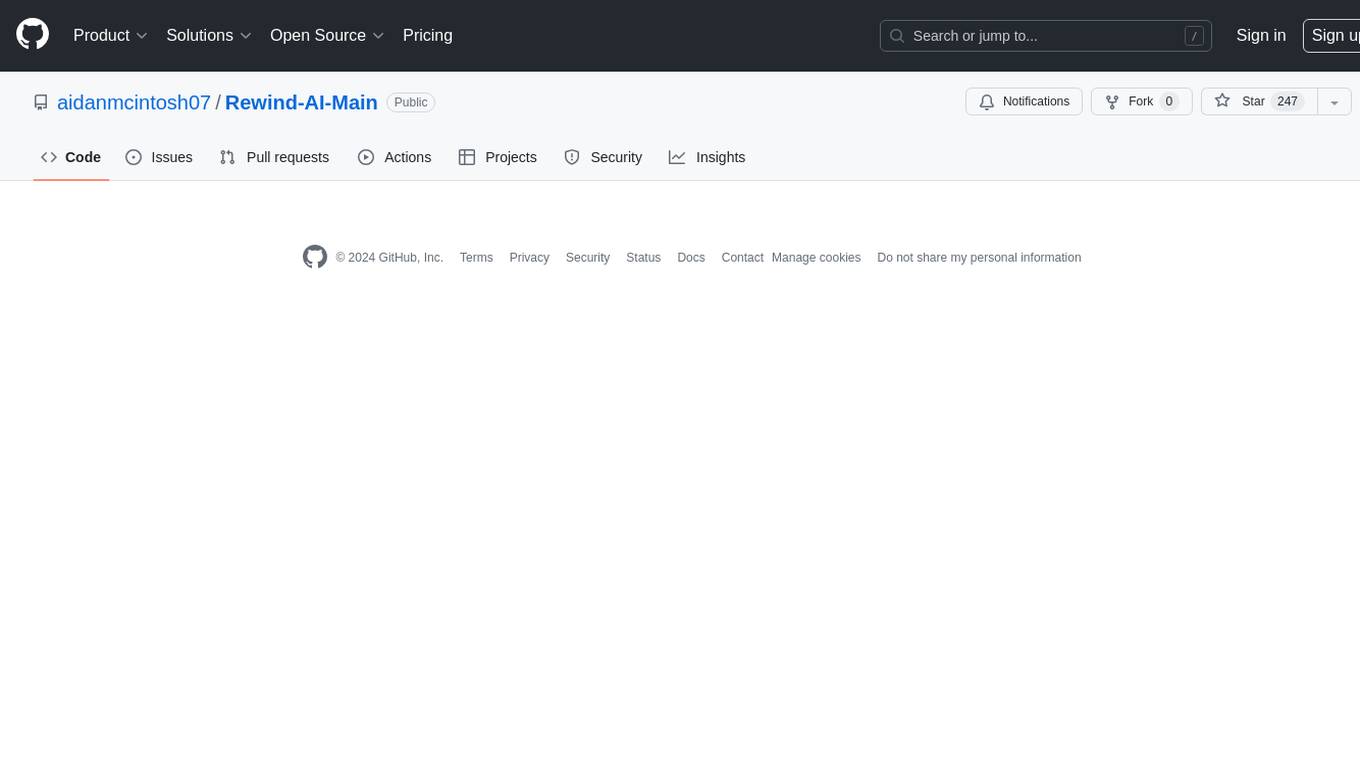
Rewind-AI-Main
Rewind AI is a free and open-source AI-powered video editing tool that allows users to easily create and edit videos. It features a user-friendly interface, a wide range of editing tools, and support for a variety of video formats. Rewind AI is perfect for beginners and experienced video editors alike.
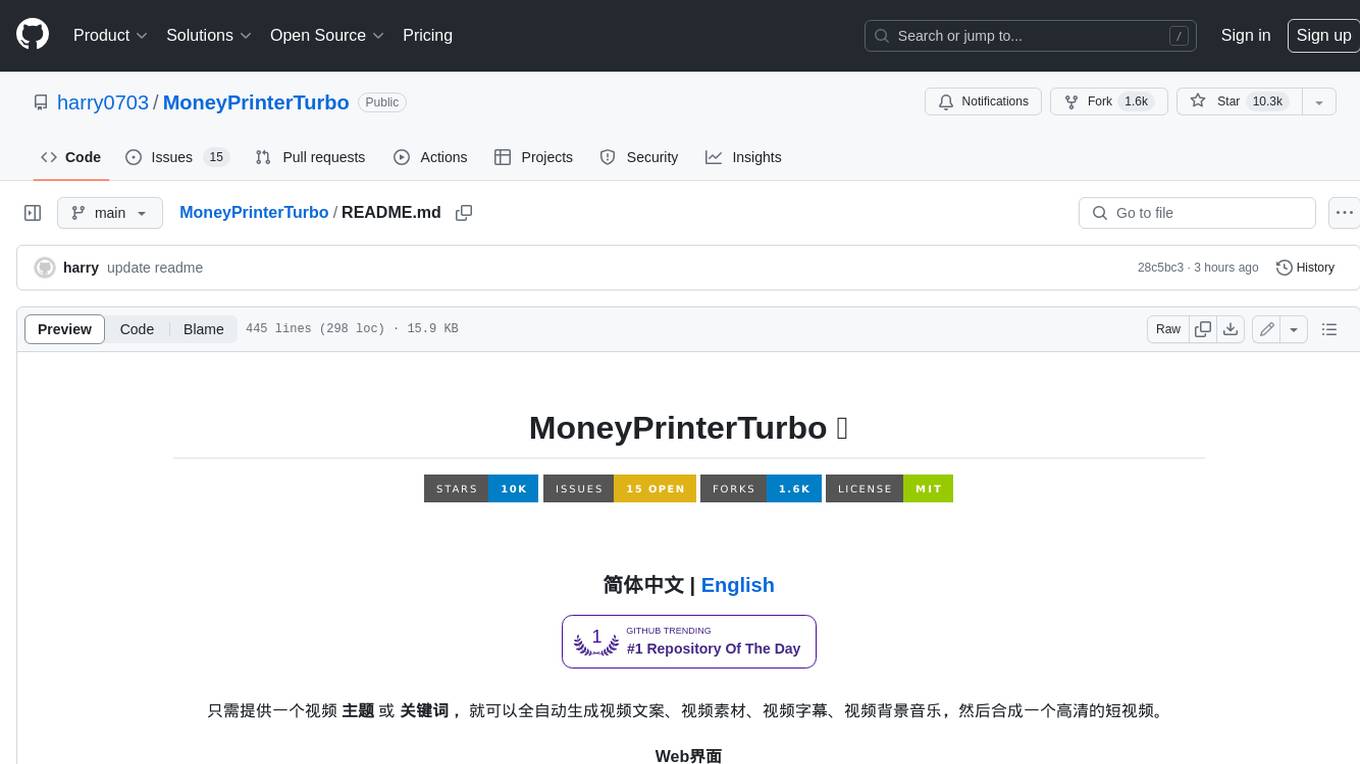
MoneyPrinterTurbo
MoneyPrinterTurbo is a tool that can automatically generate video content based on a provided theme or keyword. It can create video scripts, materials, subtitles, and background music, and then compile them into a high-definition short video. The tool features a web interface and an API interface, supporting AI-generated video scripts, customizable scripts, multiple HD video sizes, batch video generation, customizable video segment duration, multilingual video scripts, multiple voice synthesis options, subtitle generation with font customization, background music selection, access to high-definition and copyright-free video materials, and integration with various AI models like OpenAI, moonshot, Azure, and more. The tool aims to simplify the video creation process and offers future plans to enhance voice synthesis, add video transition effects, provide more video material sources, offer video length options, include free network proxies, enable real-time voice and music previews, support additional voice synthesis services, and facilitate automatic uploads to YouTube platform.
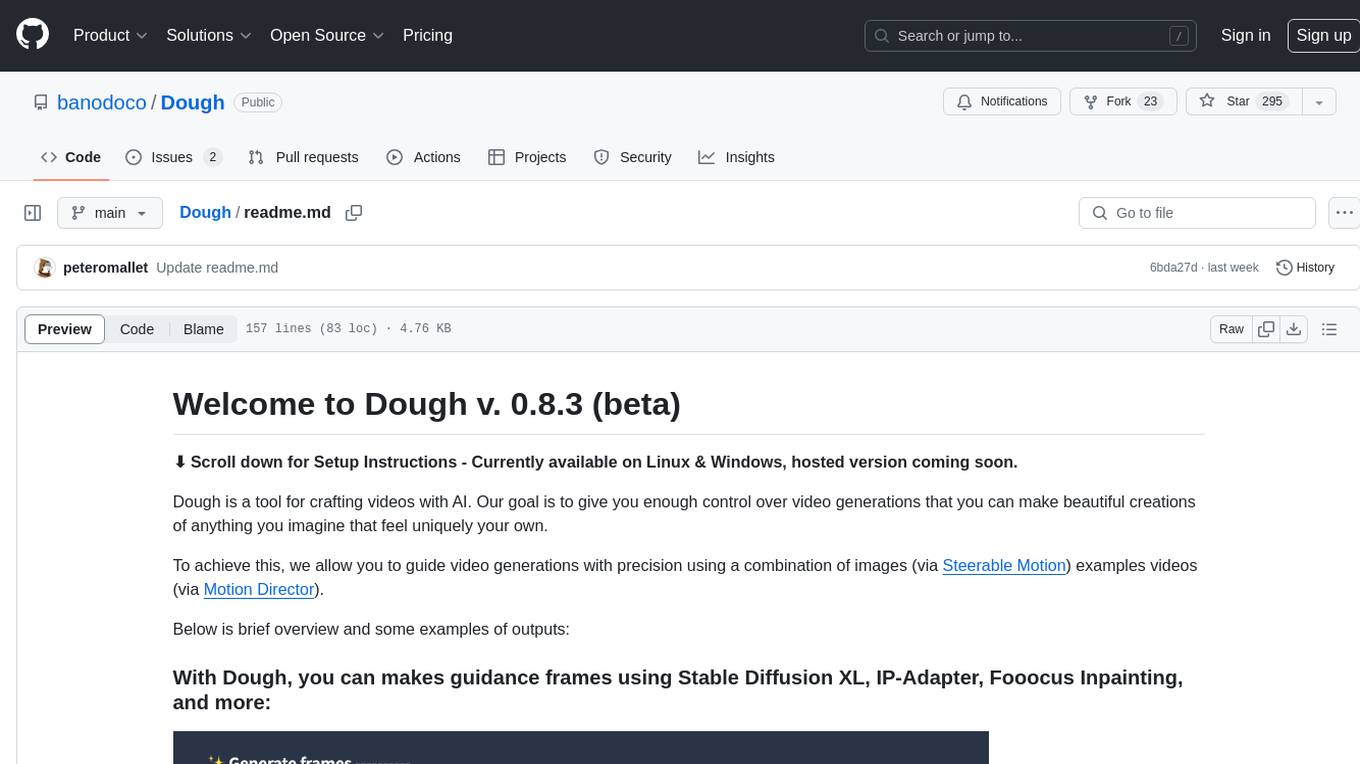
Dough
Dough is a tool for crafting videos with AI, allowing users to guide video generations with precision using images and example videos. Users can create guidance frames, assemble shots, and animate them by defining parameters and selecting guidance videos. The tool aims to help users make beautiful and unique video creations, providing control over the generation process. Setup instructions are available for Linux and Windows platforms, with detailed steps for installation and running the app.
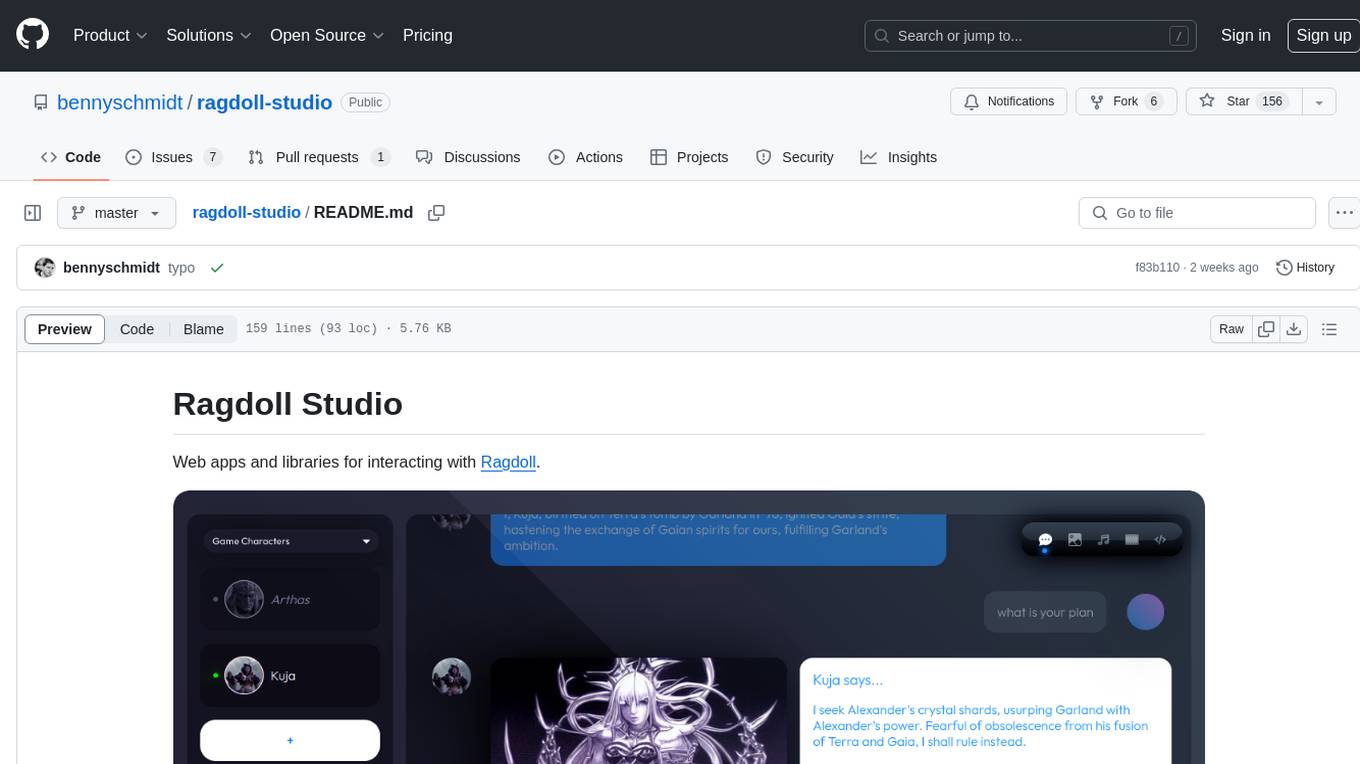
ragdoll-studio
Ragdoll Studio is a platform offering web apps and libraries for interacting with Ragdoll, enabling users to go beyond fine-tuning and create flawless creative deliverables, rich multimedia, and engaging experiences. It provides various modes such as Story Mode for creating and chatting with characters, Vector Mode for producing vector art, Raster Mode for producing raster art, Video Mode for producing videos, Audio Mode for producing audio, and 3D Mode for producing 3D objects. Users can export their content in various formats and share their creations on the community site. The platform consists of a Ragdoll API and a front-end React application for seamless usage.
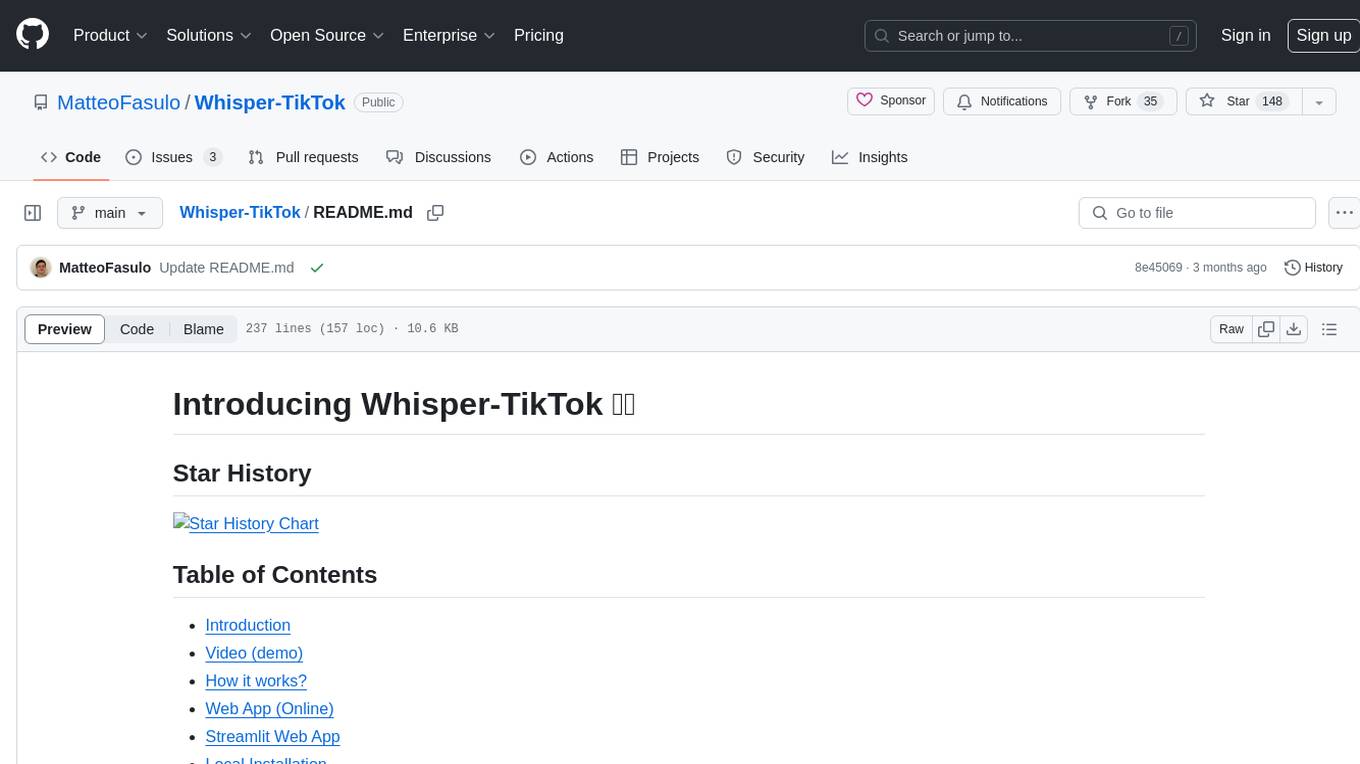
Whisper-TikTok
Discover Whisper-TikTok, an innovative AI-powered tool that leverages the prowess of Edge TTS, OpenAI-Whisper, and FFMPEG to craft captivating TikTok videos. Whisper-TikTok effortlessly generates accurate transcriptions from audio files and integrates Microsoft Edge Cloud Text-to-Speech API for vibrant voiceovers. The program orchestrates the synthesis of videos using a structured JSON dataset, generating mesmerizing TikTok content in minutes.
For similar jobs

Open-Sora-Plan
Open-Sora-Plan is a project that aims to create a simple and scalable repo to reproduce Sora (OpenAI, but we prefer to call it "ClosedAI"). The project is still in its early stages, but the team is working hard to improve it and make it more accessible to the open-source community. The project is currently focused on training an unconditional model on a landscape dataset, but the team plans to expand the scope of the project in the future to include text2video experiments, training on video2text datasets, and controlling the model with more conditions.

















